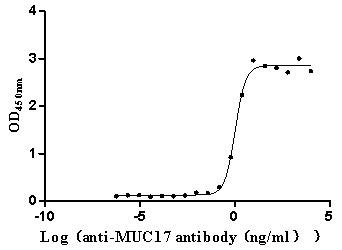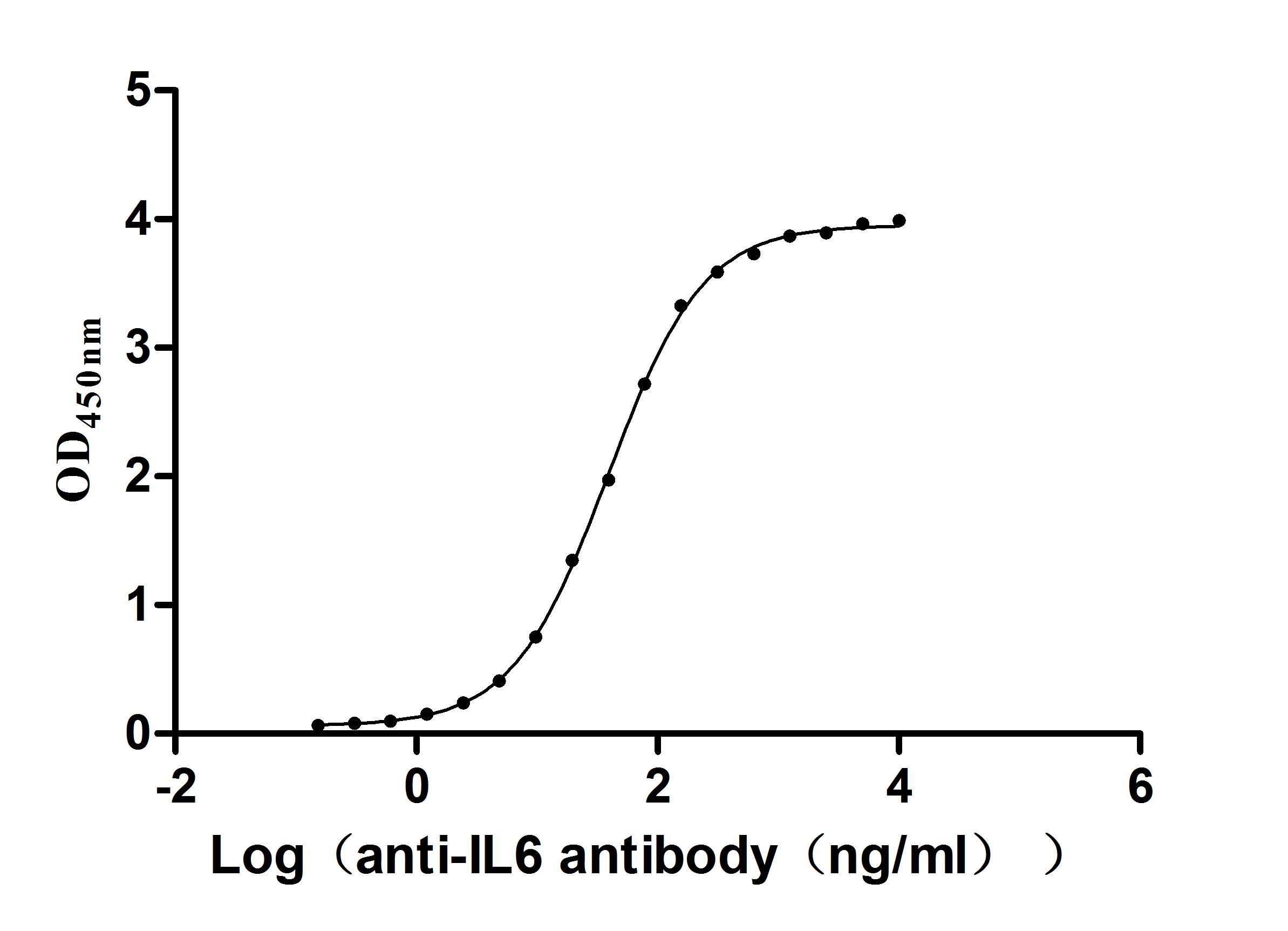Recombinant Human Nuclear receptor subfamily 1 group D member 2 (NR1D2)
-
中文名称:人NR1D2重组蛋白
-
货号:CSB-YP623948HU
-
规格:
-
来源:Yeast
-
其他:
-
中文名称:人NR1D2重组蛋白
-
货号:CSB-EP623948HU
-
规格:
-
来源:E.coli
-
其他:
-
中文名称:人NR1D2重组蛋白
-
货号:CSB-EP623948HU-B
-
规格:
-
来源:E.coli
-
共轭:Avi-tag Biotinylated
E. coli biotin ligase (BirA) is highly specific in covalently attaching biotin to the 15 amino acid AviTag peptide. This recombinant protein was biotinylated in vivo by AviTag-BirA technology, which method is BriA catalyzes amide linkage between the biotin and the specific lysine of the AviTag.
-
其他:
-
中文名称:人NR1D2重组蛋白
-
货号:CSB-BP623948HU
-
规格:
-
来源:Baculovirus
-
其他:
-
中文名称:人NR1D2重组蛋白
-
货号:CSB-MP623948HU
-
规格:
-
来源:Mammalian cell
-
其他:
产品详情
-
纯度:>85% (SDS-PAGE)
-
基因名:NR1D2
-
Uniprot No.:
-
别名:BD73; EAR 1R; EAR-1R; HZF2; Nr1d2; NR1D2_HUMAN; Nuclear receptor Rev ErbA beta variant 1; Nuclear receptor Rev ErbA beta variant 2; Nuclear receptor subfamily 1 group D member 2; Orphan nuclear hormone receptor BD73; Rev erb beta; Rev erba alpha related receptor; Rev-erb-beta; REVB; REVERBB; RVR; V-erbA-related protein 1-related
-
种属:Homo sapiens (Human)
-
蛋白长度:full length protein
-
表达区域:1-579
-
氨基酸序列MEVNAGGVIA YISSSSSASS PASCHSEGSE NSFQSSSSSV PSSPNSSNSD TNGNPKNGDL ANIEGILKND RIDCSMKTSK SSAPGMTKSH SGVTKFSGMV LLCKVCGDVA SGFHYGVHAC EGCKGFFRRS IQQNIQYKKC LKNENCSIMR MNRNRCQQCR FKKCLSVGMS RDAVRFGRIP KREKQRMLIE MQSAMKTMMN SQFSGHLQND TLVEHHEQTA LPAQEQLRPK PQLEQENIKS SSPPSSDFAK EEVIGMVTRA HKDTFMYNQE QQENSAESMQ PQRGERIPKN MEQYNLNHDH CGNGLSSHFP CSESQQHLNG QFKGRNIMHY PNGHAICIAN GHCMNFSNAY TQRVCDRVPI DGFSQNENKN SYLCNTGGRM HLVCPLSKSP YVDPHKSGHE IWEEFSMSFT PAVKEVVEFA KRIPGFRDLS QHDQVNLLKA GTFEVLMVRF ASLFDAKERT VTFLSGKKYS VDDLHSMGAG DLLNSMFEFS EKLNALQLSD EEMSLFTAVV LVSADRSGIE NVNSVEALQE TLIRALRTLI MKNHPNEASI FTKLLLKLPD LRSLNNMHSE ELLAFKVHP
-
蛋白标签:Tag type will be determined during the manufacturing process.
The tag type will be determined during production process. If you have specified tag type, please tell us and we will develop the specified tag preferentially. -
产品提供形式:Lyophilized powder
Note: We will preferentially ship the format that we have in stock, however, if you have any special requirement for the format, please remark your requirement when placing the order, we will prepare according to your demand. -
复溶:We recommend that this vial be briefly centrifuged prior to opening to bring the contents to the bottom. Please reconstitute protein in deionized sterile water to a concentration of 0.1-1.0 mg/mL.We recommend to add 5-50% of glycerol (final concentration) and aliquot for long-term storage at -20℃/-80℃. Our default final concentration of glycerol is 50%. Customers could use it as reference.
-
储存条件:Store at -20°C/-80°C upon receipt, aliquoting is necessary for mutiple use. Avoid repeated freeze-thaw cycles.
-
保质期:The shelf life is related to many factors, storage state, buffer ingredients, storage temperature and the stability of the protein itself.
Generally, the shelf life of liquid form is 6 months at -20°C/-80°C. The shelf life of lyophilized form is 12 months at -20°C/-80°C. -
货期:Delivery time may differ from different purchasing way or location, please kindly consult your local distributors for specific delivery time.Note: All of our proteins are default shipped with normal blue ice packs, if you request to ship with dry ice, please communicate with us in advance and extra fees will be charged.
-
注意事项:Repeated freezing and thawing is not recommended. Store working aliquots at 4°C for up to one week.
-
Datasheet :Please contact us to get it.
靶点详情
-
功能:Transcriptional repressor which coordinates circadian rhythm and metabolic pathways in a heme-dependent manner. Integral component of the complex transcription machinery that governs circadian rhythmicity and forms a critical negative limb of the circadian clock by directly repressing the expression of core clock components ARNTL/BMAL1 and CLOCK. Also regulates genes involved in metabolic functions, including lipid metabolism and the inflammatory response. Acts as a receptor for heme which stimulates its interaction with the NCOR1/HDAC3 corepressor complex, enhancing transcriptional repression. Recognizes two classes of DNA response elements within the promoter of its target genes and can bind to DNA as either monomers or homodimers, depending on the nature of the response element. Binds as a monomer to a response element composed of the consensus half-site motif 5'-[A/G]GGTCA-3' preceded by an A/T-rich 5' sequence (RevRE), or as a homodimer to a direct repeat of the core motif spaced by two nuclegotides (RevDR-2). Acts as a potent competitive repressor of ROR alpha (RORA) function and also negatively regulates the expression of NR1D1. Regulates lipid and energy homeostasis in the skeletal muscle via repression of genes involved in lipid metabolism and myogenesis including: CD36, FABP3, FABP4, UCP3, SCD1 and MSTN. Regulates hepatic lipid metabolism via the repression of APOC3. Represses gene expression at a distance in macrophages by inhibiting the transcription of enhancer-derived RNAs (eRNAs). In addition to its activity as a repressor, can also act as a transcriptional activator. Acts as a transcriptional activator of the sterol regulatory element-binding protein 1 (SREBF1) and the inflammatory mediator interleukin-6 (IL6) in the skeletal muscle. Plays a role in the regulation of circadian sleep/wake cycle; essential for maintaining wakefulness during the dark phase or active period. Key regulator of skeletal muscle mitochondrial function; negatively regulates the skeletal muscle expression of core clock genes and genes involved in mitochondrial biogenesis, fatty acid beta-oxidation and lipid metabolism. May play a role in the circadian control of neutrophilic inflammation in the lung.
-
基因功能参考文献:
- Rev-erbalpha regulates Cyp7a1 and cholesterol metabolism through its repression of the Lrh-1 receptor. PMID: 29237721
- Data show that miR-210 inhibits the expression of nuclear receptor subfamily 1, group D, member 2 (NR1D2), particularly in cryptorchidic tissues. PMID: 27562222
- These results demonstrate the importance of the Rev-erbbeta HRM in regulating interactions with heme and NCoR1 and advance our understanding of how signaling through HRMs affects the major cellular processes of circadian rhythm maintenance and metabolism. PMID: 28500133
- heme is involved in regulating the degradation of Rev-erbbeta in a manner consistent with its role in circadian rhythm maintenance PMID: 26670607
- Together, the findings demonstrate an anti-inflammatory effect, downregulating of MMP-9 and CCL2 transcription, of astroglial REV-ERBs activation through HDAC3-dependent and HDAC3-independent mechanisms. PMID: 26616049
- REV-ERBbeta plays a role in supporting cancer cell viability when autophagy is compromised. PMID: 25023698
- REV-ERB-ALPHA circadian gene variant associates with obesity in two independent populations: Mediterranean and North American. PMID: 24173768
- Cobalt protoporphyrin IX (CoPP) and zinc protoporphyrin IX (ZnPP) are ligands that bind directly to the REV-ERBs. However, instead of mimicking the agonist action of heme, CoPP and ZnPP function as antagonists of REV-ERB function. PMID: 24872411
- Our results suggest that the REV-ERBalpha rs2071427 polymorphism modulates body fat mass in both adult and young people. PMID: 22828941
- oxidative stress leads to oxidation of cysteine(s), thus releasing heme from Rev-erbbeta and altering its transcriptional activity. PMID: 21123168
- Nuclear receptor rev-erb-{alpha} circadian gene variants have a role in response to lithium carbonate in bipolar affective disorder PMID: 20348464
- Rev-erbbeta modulates the apoCIII gene expression by recruiting different transcription co-activator or co-repressor. PMID: 17996965
- heme regulation of REV-ERBs may link the control of metabolism and the mammalian clock PMID: 18037887
显示更多
收起更多
-
亚细胞定位:Nucleus. Cytoplasm.
-
蛋白家族:Nuclear hormone receptor family, NR1 subfamily
-
组织特异性:Widely expressed. Expressed at high levels in the liver, adipose tissue, skeletal muscle and brain. Expression oscillates diurnally in the suprachiasmatic nucleus (SCN) of the hypothalamus as well as in peripheral tissues.
-
数据库链接:
HGNC: 7963
OMIM: 602304
KEGG: hsa:9975
STRING: 9606.ENSP00000310006
UniGene: Hs.37288
Most popular with customers
-
Recombinant Human Claudin-6 (CLDN6)-VLPs (Active)
Express system: Mammalian cell
Species: Homo sapiens (Human)
-
Recombinant Human Mucin-17 (MUC17), partial (Active)
Express system: Mammalian cell
Species: Homo sapiens (Human)
-
Recombinant Human Desmoglein-3 (DSG3), partial (Active)
Express system: Baculovirus
Species: Homo sapiens (Human)
-
Recombinant Human Tomoregulin-2 (TMEFF2), partial (Active)
Express system: Mammalian cell
Species: Homo sapiens (Human)
-
Recombinant Human Carcinoembryonic antigen-related cell adhesion molecule 6 (CEACAM6) (Active)
Express system: Mammalian cell
Species: Homo sapiens (Human)
-
Recombinant Human C-type lectin domain family 4 member C (CLEC4C), partial (Active)
Express system: Mammalian cell
Species: Homo sapiens (Human)
-
Recombinant Mouse Gastric inhibitory polypeptide receptor (Gipr), partial (Active)
Express system: Mammalian cell
Species: Mus musculus (Mouse)
-


-AC1.jpg)

















